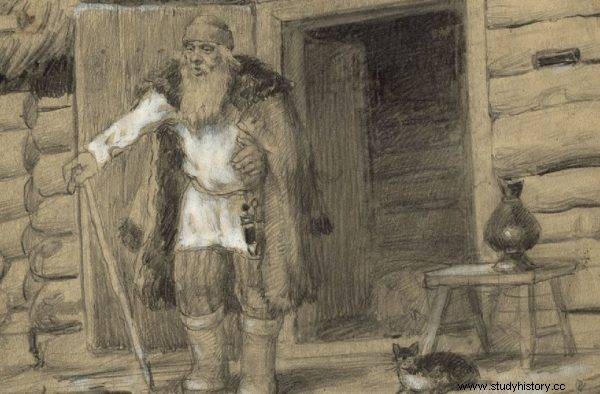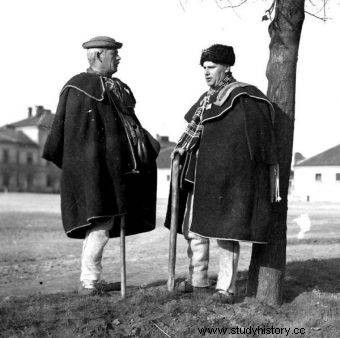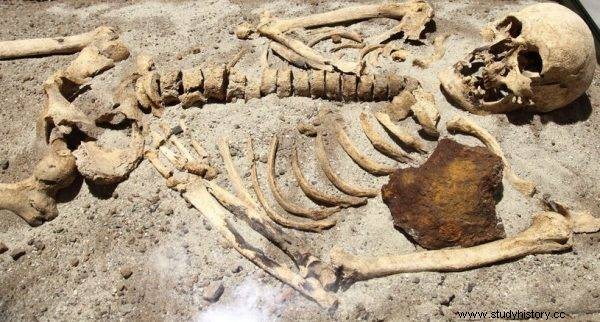Paid to kill monsters tormenting people. Scythe, aspen stake, magic. Perhaps Geralt of Rivia is a literary fiction, but Gyrda of Blechnarki or Bacza of Keckovec really existed. And they knew their job.
They did not look like the famous white-haired bully from Sapkowski's witcher saga. But it was these inconspicuous sheep shepherds, church wardens and village herbalists who turned into real ghost hunters when needed.
Priests, called by our ancestors to chase away evil powers, are just the tip of the iceberg. God's servants were helped by people who used more than prayer. And they weren't afraid to get blood on their hands!
For trouble… churchy
Even an experienced churchman could become a real witcher. The story of such a watchman from Biała was once recorded by Jan Karłowicz. And it was like this…
Here's night after night someone was banging on the iron gates of the cemetery . The old watchman, when he realized that he was dealing with a deceased who had risen from the grave, quickly settled the matter. He took the needle, threaded it with a ball of thread, and stuck it into the phantom before it could sink its rotten teeth into it.
When the living dead returned to the grave in the morning, the church, like Theseus on Ariadne's thread, reached the monster's hideout . The next day, together with the priest, they dug up the grave, put a three-groszy coin in the mouth of the striga (i.e. the so-called obol of the dead, a symbolic payment for transport to the afterlife dating back to antiquity) and put the corpse onto its belly. He has not left his grave since then.
A similar team for the undead - a priest plus a church member - appears in the legend of Kasia near Krakow, waiting for her beloved Jaś to return from the war. One evening she lived to see it, but the boy turned out to be a ghost. The girl managed to escape when the monster wanted to drag her to the grave with him . The next day she returned with the priest and the churchman. When the grave of John the Ghost was opened, resentful and furious, he began to threaten his fiancée. But he didn't get along for long, because the "witchers" had chopped off his head.
Under the shepherd's whip
The quick-wits also took action to fight the wraiths circulating around the world. In Kongresówka, such a specialist from the village of Młynarze near Maków Mazowiecki, for a small fee, chased away various nightmares from farms. She mumbled spells, and incensed houses and smacked them with foul rags . However, it is hard to suspect that the real monsters would scare the old lady smoking herbs.
The methods of the Shepherd from Chernostov who fought the monsters at the end of the 19th century , operating in the same region, were more impressive. . As you can read in the works devoted to ethnography, he was a man-institution in the region. Apparently, he was sent for him even from aristocratic mansions near Łomża and Płock. He arrived at the scene of the action armed with a sack that he would not let anyone look into.

This is what the Shepherd from Chornostov might have looked like (source:public domain).
After which he spent the night alone in the "possessed" household . It is not known what the struggle with the ghouls looked like - you could only hear the blood-curdling sounds of fighting, moans and noises like the crack of a whip. In the morning, a badly battered sheepdog with a full sack emerged from the building. What was in it was immediately drowned in the river or lake.
He had a reputation for being invincible, but also fond of money. According to legend, his streak ended when he once accepted a bribe from… a captured scourge. Greed did not pay off - since then, the evil spirits no longer listened to him, and he himself died a beggar.
Headless eleven year old
Well, fighting night ghosts and sack-drowning are easy to simulate. It was different in the case of the actions of witchers circulating in the Podkarpacie region in the Lemko region . They were called watchmen (not to be confused with shepherds - shepherds of sheep).
There were many of them among the Lemkos. The most important ones were:Leszko Babej, called Gyrda from Blechnarki and the other called Bacza from Keckovec on the Slovak side. Their legend remains, and also the lonely stone tombstone of Babej, which is left in the ruined cemetery in Blechnarka - wrote ethnographer Roman Reinfuss.
The Bacchus appeared on the scene, called like an ambulance to deal with the living dead tormenting their neighbors.
An interesting example of the activity of professional ghost tamers took place before World War I in Radoszyce. Two huge peasants were brought to the deceased 11-year-old girl who did not give peace to her relatives - writes the archaeologist Piotr Kotowicz.

Two Lemkos - this is what the guardians of the ghoul hunting tactics might have looked like (source:public domain).
Before the awaiting task, food and vodka were prepared for them, but they did not accept the invitation. One of them, on the other hand, lit a candle and read a book late. Half an hour before midnight, they went with the relatives of the deceased to the cemetery, dug the coffin, but the girl was not in it .
However, they noticed her running through the village and after the chase they caught her near the last buildings. Then they took her to the grave, cut off her head and put her between her legs. They were wet with sweat when they got home. However, the treatment turned out to be so successful that the girl stopped walking .
And the scaring is over…
Commandments of the ghost hunter
The following picture of their methods of operation emerges from the "witcher" practice of our hunters of striga and other ghouls:first, they were digging up the suspect's grave. Secondly, they turned the body on its stomach so that it bites into the ground and cannot find a way out of the grave.
Third, they pinned the carcass with a pin or a harrow tooth just in case. And finally, fourthly, the crowning achievement of the whole action was the decapitation of a dead man. The skull had to be placed between the legs of the former wraith.

This is what antivampiric burials looked like:an example from Bulgaria (author:Bin im Garten, license:CC BY-SA 3.0).
In the village of Jawornik near Sanok, there was probably not one deceased who would keep his head intact - wrote the nineteenth-century ethnographer Oskar Kolberg. The enthusiasm of the native monster hunters spread over the whole country, as was Poland as long and wide. Between the seventeenth and twentieth centuries, the heads of "ghosts" were cut off with sickles and hoes near Kraków, Łódź and Gdańsk, in Masuria and Volhynia.
In turn, early medieval "anti-vampire" burials to prevent the return of the dead from the afterlife, scientists found, among others, in Brześć Kujawski, Kałdus and Niemcza.
The victims of these practices were dead people who aroused suspicions even for completely innocent reasons, including those who stood out during their lifetime by an unusual appearance or due to illness, for example, spitting blood.

Vampire hunter set. Our churchmen, healers and watchmen did not need this kind of help for amateurs (author:Josh Berglund, license:CC BY 2.0).
Sometimes the wrong background was enough. While examining the "anti-vampire" burials from the 17th and 18th centuries in Drawsko on the Noteć river, Polish and American researchers wondered if the local "vampires" were not unwanted newcomers, immigrants! However, the analyzes in this case ruled it out.
Nevertheless, among the "suspects" in Polish villages, there were traditionally people of "uncertain" origins - for example, from families where someone practiced magic or was once taken for a phantom. Who knows if the target was not even the unfortunate Shepherd from Mazovia, who first caught the nightmares himself, and then let them bribe him ...
Bibliography:
- Baranowski Bohdan, In the circle of ghosts and werewolves, Wydawnictwo Łódzkie 1981.
- Kotowicz Piotr, Vampire from ul. Zamkowa 20 in Sanok , "The Sanocki Yearbook" vol. X / 2011.
- Reinfuss Roman, In the footsteps of the Lemkos , Publishing House of PTTK "Kraj" 1990.
- Shroudeater.com (European Vampire Research).
